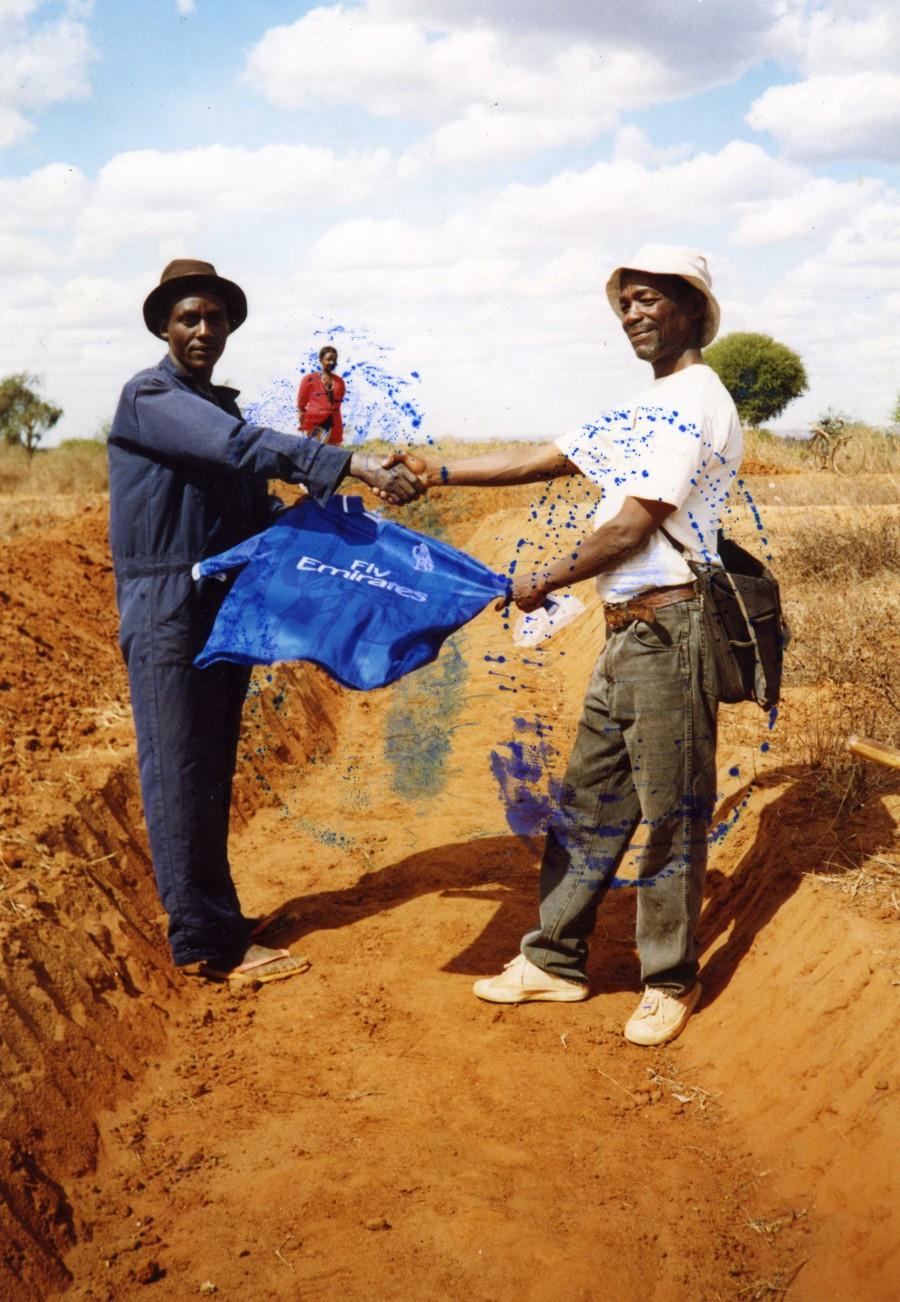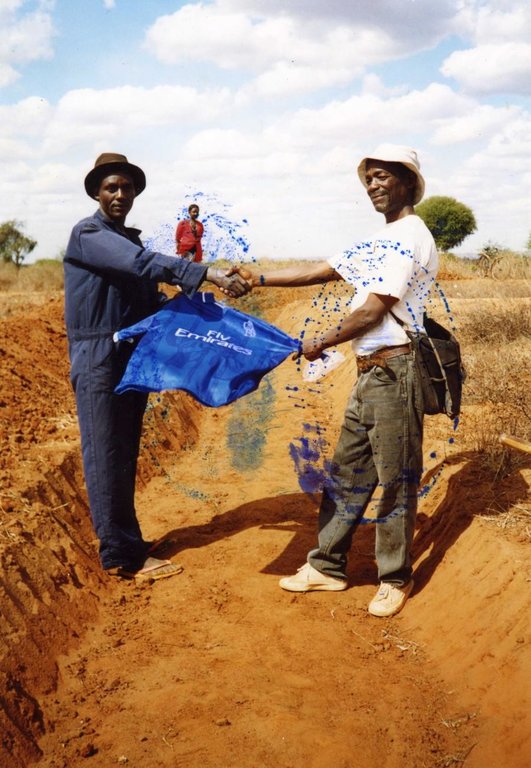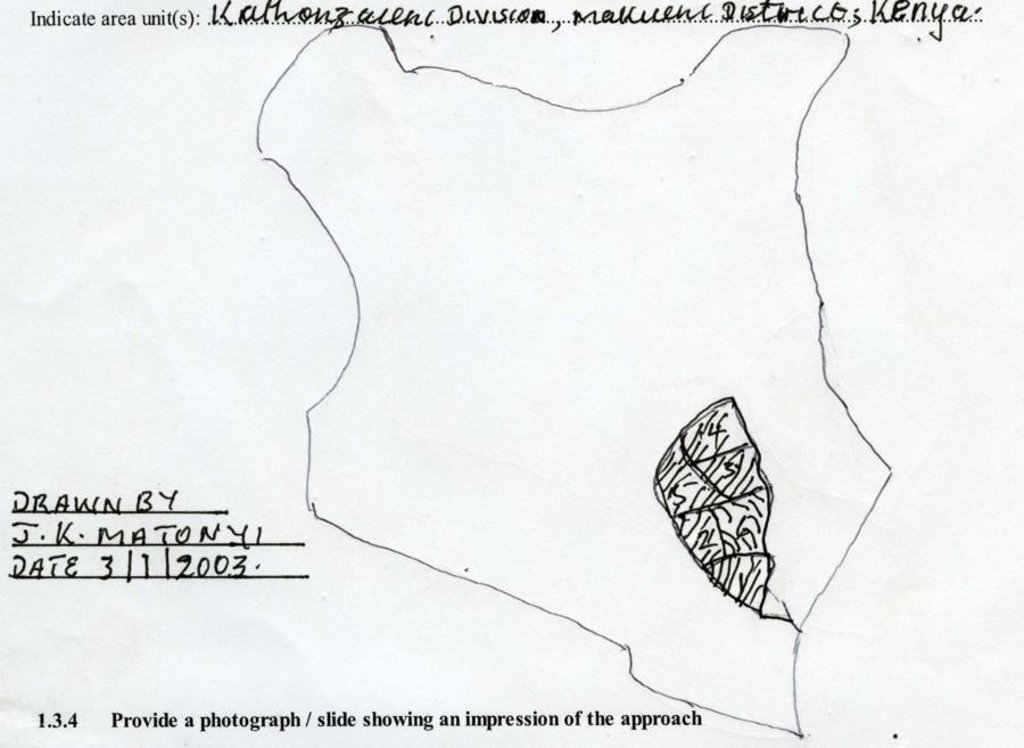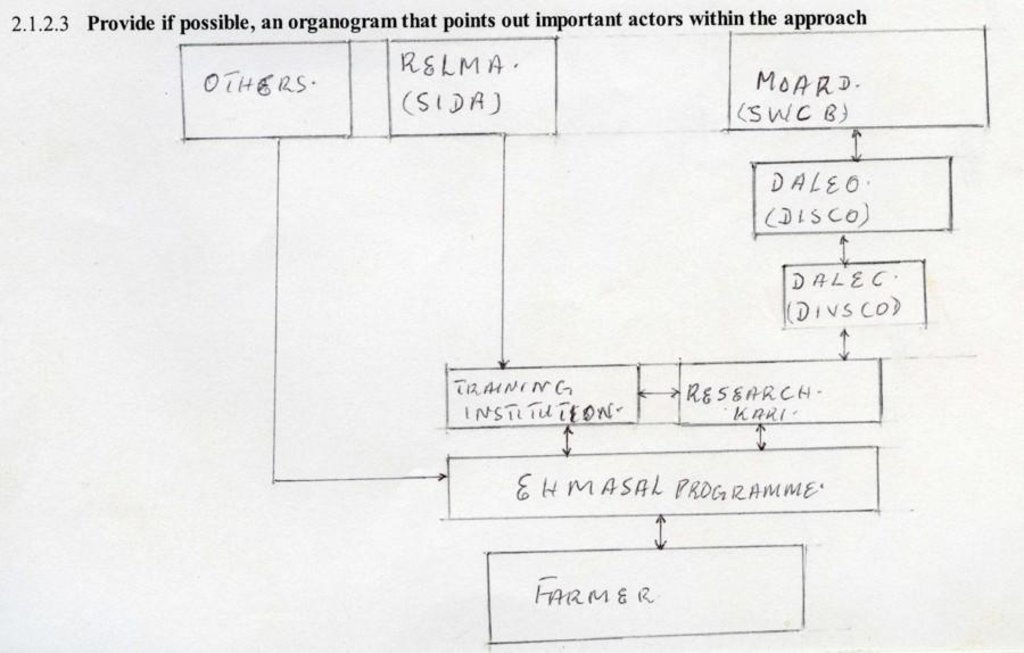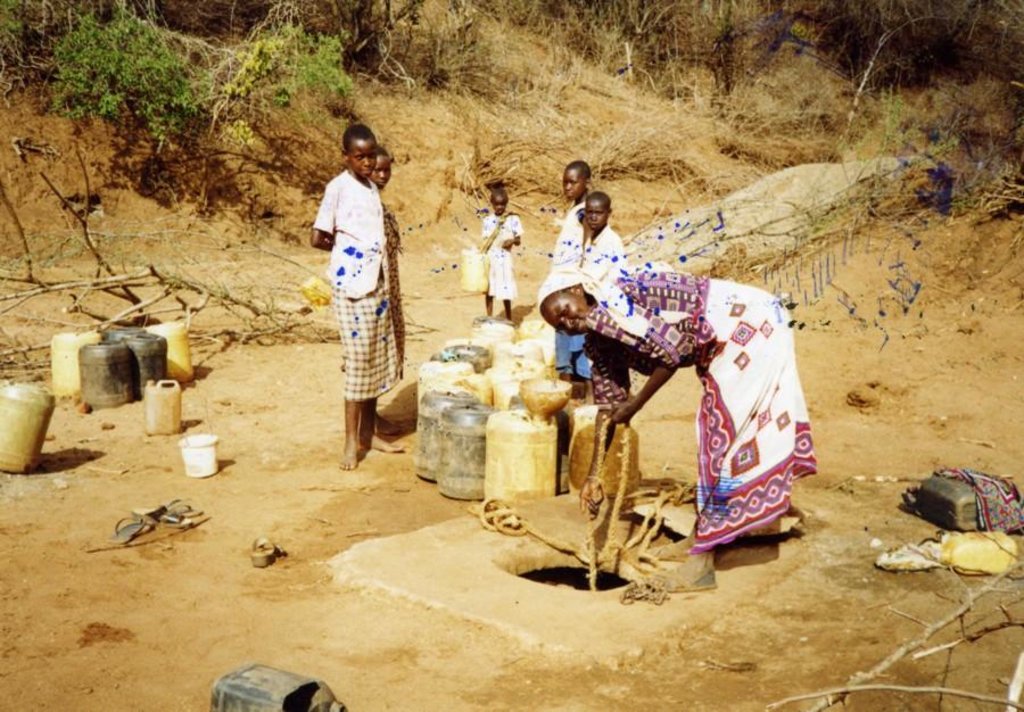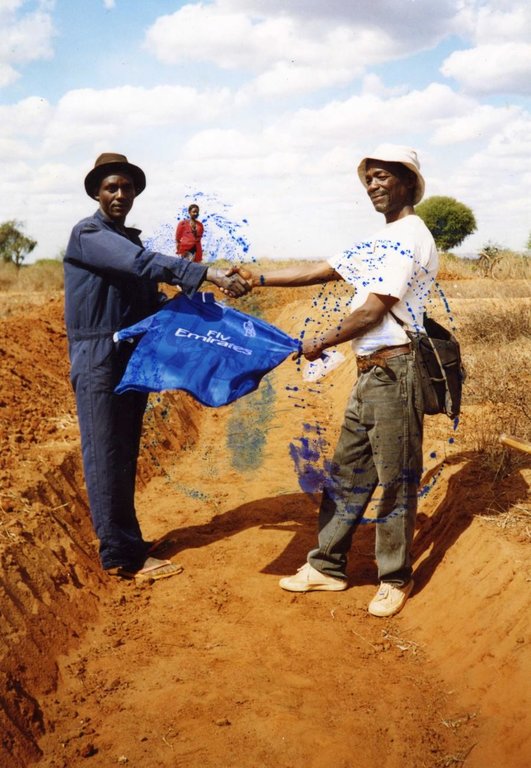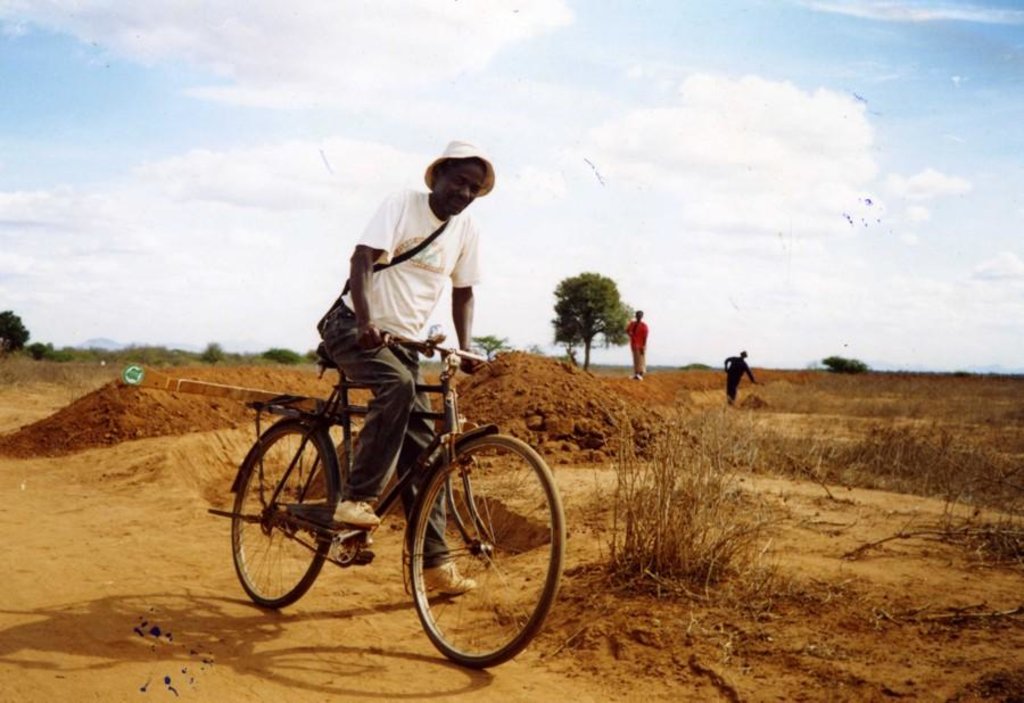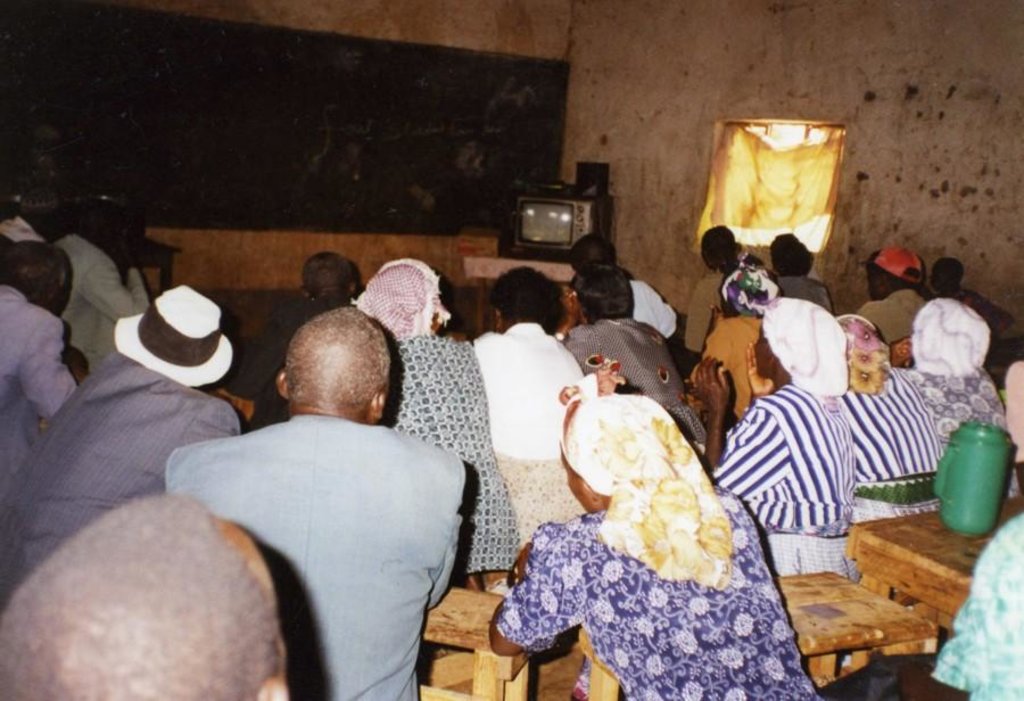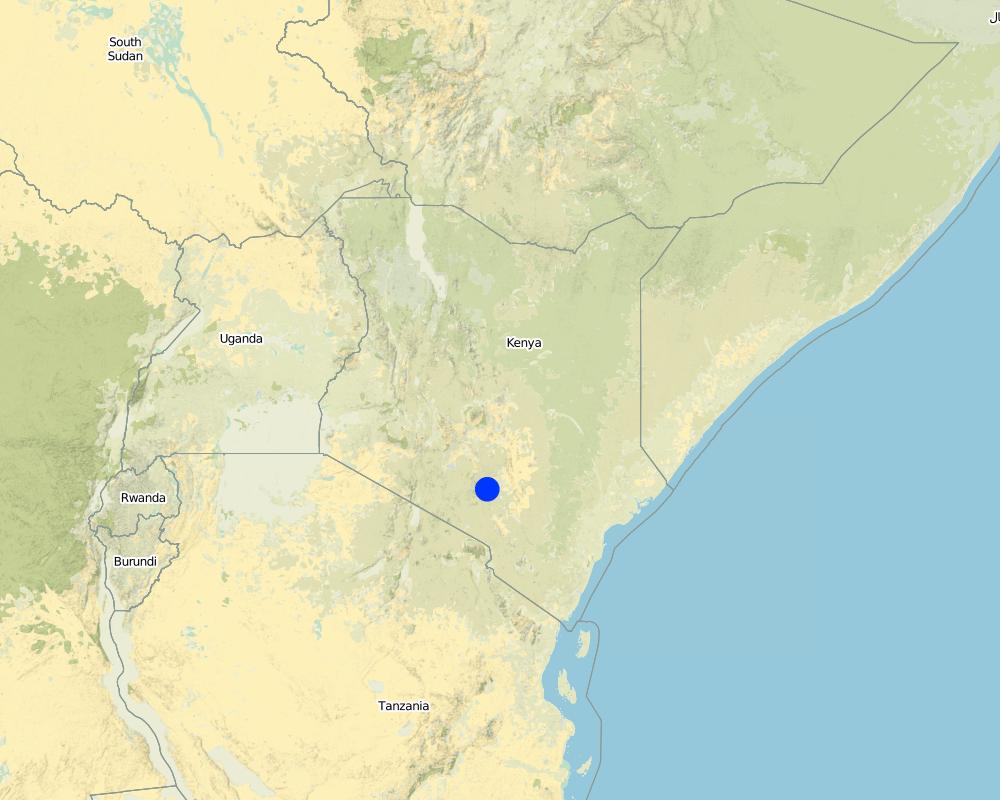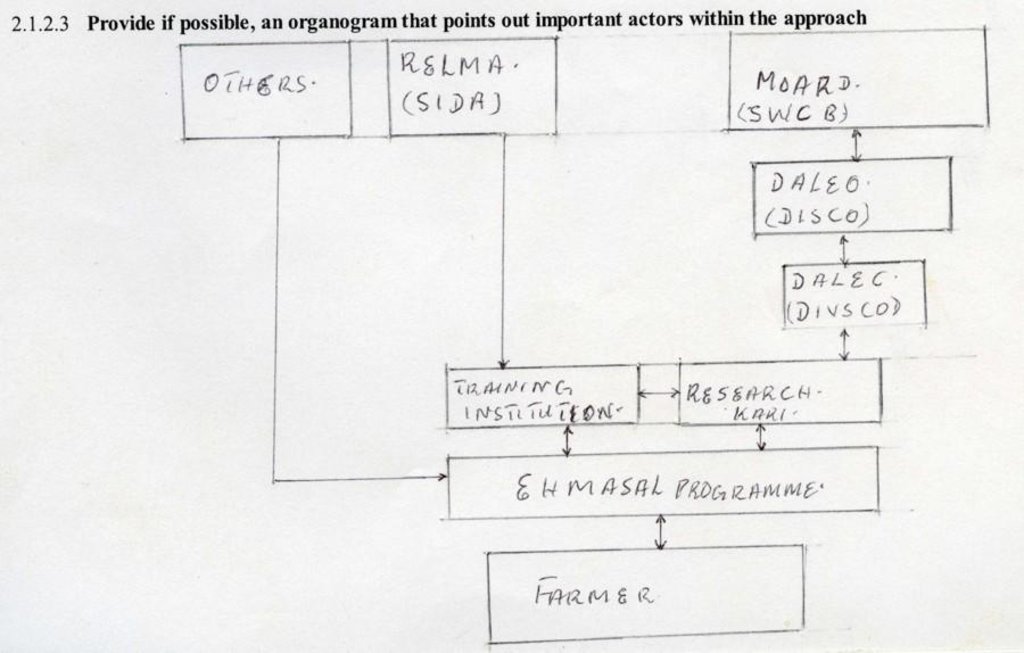water harvesting [Quênia]
- Criação:
- Atualização:
- Compilador/a: Philippe Zahner
- Editor: –
- Revisor: Fabian Ottiger
approaches_2356 - Quênia
Veja as seções
Expandir tudo Recolher tudo1. Informação geral
1.2 Detalhes do contato das pessoas capacitadas e instituições envolvidas na avaliação e documentação da abordagem
Especialista em GST:
Especialista em GST:
Mutunga Kathinji
Ministry of agriculture and rural development national SWC branch.
P.O.Box 30028 Nairobi
Quênia
Especialista em GST:
Adual Alex R.
RELMA/SIDA ICRAF house
P.O.Box 63403 Nairobi
Quênia
Nome da(s) instituição(ões) que facilitou(ram) a documentação/avaliação da Abordagem (se relevante)
Swiss Agency for Development and Cooperation (DEZA / COSUDE / DDC / SDC) - SuíçaNome da(s) instituição(ões) que facilitou(ram) a documentação/avaliação da Abordagem (se relevante)
Ministry of Agriculture, Livestock and Fisheries (MoA) - QuêniaNome da(s) instituição(ões) que facilitou(ram) a documentação/avaliação da Abordagem (se relevante)
International Centre for Research in Agroforestry (ICRAF) - Quênia1.3 Condições em relação ao uso da informação documentada através de WOCAT
O compilador e a(s) pessoa(s) capacitada(s) aceitam as condições relativas ao uso de dados documentados através do WOCAT:
Sim
1.4 Referência ao(s) questionário(s) sobre tecnologias da GST
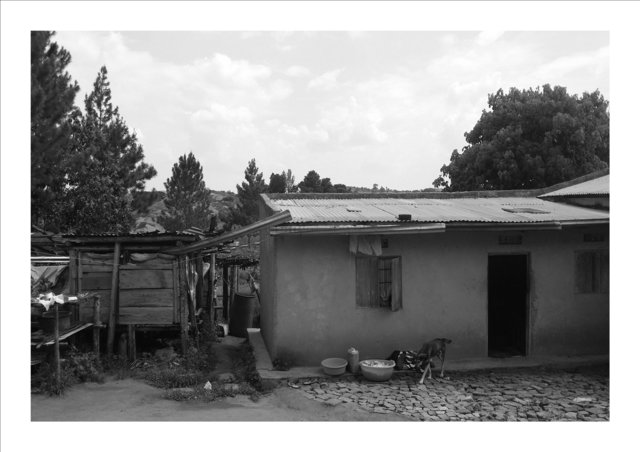
Wooden water reservoir for rain water harvesting. [Uganda]
A gutter system constructed on the farmer’s house-roof collects rainwater and directs it into a constructed reservoir raised off the ground with interior walls lined with water-proof tarpaulin. The reservoir has a maximum capacity of 8,000 liters of water; clean enough for irrigation, livestock and domestic use during seasons of …
- Compilador/a: Aine Amon
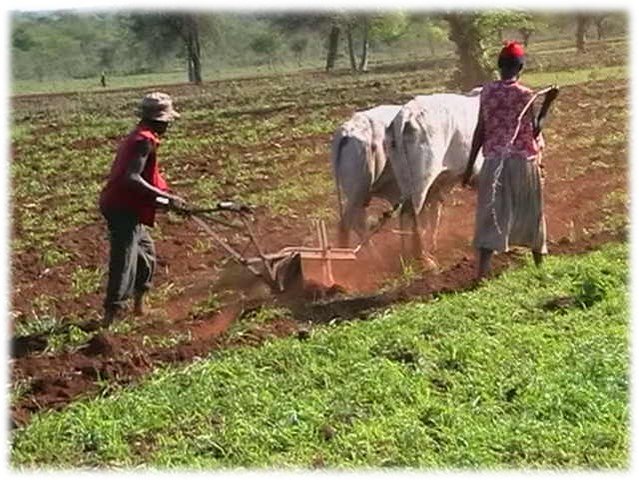
Micro-catchments for rainwater harvesting [Quênia]
Ox-ploughed furrow micro-catchments are intentionally built as part of seedbed preparation to harvest rainwater. Commonly used in dryland environments, the micro-catchment prolong water availability for seed germination and growth and development of the emerging seedlings.
- Compilador/a: Kevin Mganga
2. Descrição da abordagem de GST
2.1 Descrição curta da abordagem
Water harvesting for agricultural production in ASALS.
2.2 Descrição detalhada da abordagem
Descrição detalhada da abordagem:
Aims / objectives: Water harvesting to enhance extra moisture and for reduced risks of crop failure. The technology combines retention/infiltration ditches, bench terraces, appropriate tillaging, manure use, water channels diverting run off from either high ways or natural waterways and stabilization of SWC embankment. Implementation is made by land users with guidance of SWC specialists. Land users may be a group or individual, though the land use type is individual ownership.
Other important information: Most of part 2: specification of SWC approach, QA2.11.3-QA2.5.2.3 were answered with assumptions since there never existed other projects in the area before this indigeneous one known as extra humid in arid and semi-arid lands (EHMASAL) programme established in 2000 to provide land users with the existing SWC technologies and methods of approaches to meet the prevailing need of self-sufficience and food security. The programme strategies are attached.
2.3 Fotos da abordagem
2.5 País/região/locais onde a abordagem foi aplicada
País:
Quênia
Região/Estado/Província:
Eastern province
Map
×2.6 Datas de início e término da abordagem
Indique o ano de início:
2000
2.7 Tipo de abordagem
- Baseado em projeto/programa
2.8 Principais metas/objetivos da abordagem
The Approach focused mainly on SLM with other activities (Timeliness in planting/transplanting, seed selection, seedlings variety and breeds for the AEZ.)
To harvest runoff and spread it on cropped area to maximize agricultural productivity. To improve crop moisture requiremnet. To reduce risks of crop failure stimulated by aridity in ASALs. To control soil erosion by water and wind. To improve the inflitration rate. To enhance food security for self-sufficiency and reliance.
The SLM Approach addressed the following problems: Inadequency of soil moisture resulting to crop failure. Inefficiency of approach to improve the situation. Fertility depletion due to continuous cultivation. Soil crusting caused by erosion, poor tillaging, overgrazing and deforestation (degadation).
2.9 Condição que propiciam ou inibem a implementação de tecnologia/tecnologias aplicada(s) segundo a abordagem
Disponibilidade/acesso a recursos e serviços financeiros
- Inibitivo
The much need be done on SWC in ASAL is beyond the sole land user for hand
Treatment through the SLM Approach: It requires financial support by source of loans and market orientation
Quadro jurídico (posse de terra, direitos de uso da terra e da água)
- Propício
The existing land ownership, land use rights / water rights greatly helped the approach implementation: Land ownership/land use rights help implementation of the approach since benefits are realized by the sole land user.
- Inibitivo
No empowerment on land use law or bylaws
Treatment through the SLM Approach: Enforcement by legislation on land use policy.
Conhecimento sobre GST, acesso a suporte técnico
- Inibitivo
poor land treatment-plans, poor land husbandry, low knowledge
Treatment through the SLM Approach: Interaction in land use change, especially with SWC specialists
3. Participação e papel das partes interessadas envolvidas
3.1 Partes interessadas envolvidas na abordagem e seus papéis
- Usuários de terra/comunidades locais
Land user/local SWC specialists. Working land users were work equally divided between men and women (The family leader organizes for activity implementation either family labour or casuals). Women are majority for reason that men are engaged on off-farm. Employmentproportion is about 3 women to 1 man. Mostly women in public meetings and open field days
- Especialistas em GST/ consultor agrícola
- Governo nacional (planejadores, responsáveis pelas decisões)
Water harvest for agricultural production RESCU 1996. Run off farming ministry of agriculture, Nairobi
3.2 Envolvimento do usuários de terra/comunidades locais nas diferentes fases da abordagem
| Envolvimento do usuários de terra/comunidades locais | Especifique quem estava envolvido e descreva as atividades | |
|---|---|---|
| Iniciação/motivação | Participativo | Mainly:public meetings; partly: workshops/seminars; public meetings for initial awareness. Workshops/seminars for technical assistance for approach |
| Planejamento | Participativo | Mainly: workshops/seminars; partly: public meetings; innovators land users seminar |
| Implementação | Automobilização | |
| Monitoramento/avaliação | Nenhum | Mainly: reporting; partly: measurements/observations; correct dimensions, monthly progress report |
| Research | Nenhum |
3.3 Fluxograma (se disponível)
3.4 Decisão sobre a seleção de tecnologia/tecnologias de GST
Especifique quem decidiu sobre a seleção de tecnologia/tecnologias a serem implementadas:
- Principalmente especialistas em GST, após consulta com usuários da terra
Explique:
consultative for land use change
Decisions on the method of implementing the SLM Technology were made by mainly by land users supported by SLM specialists. land users implemented voluntarily.
4. Suporte técnico, reforço das capacidades e gestão do conhecimento
4.1 Reforço das capacidades/formação
Foi oferecida formação aos usuários da terra/outras partes interessadas?
Sim
Especifique quem foi capacitado:
- Usuários de terra
- extensionists/trainers
Tipo de formação:
- Em exercício
- Áreas de demonstração
- Reuniões públicas
Assuntos abordados:
Only field days and practical substitutes training for a fact that the programme has no source of finance to support trainings.
4.2 Serviço de consultoria
Os usuários de terra têm acesso a um serviço de consultoria?
Sim
Descreva/comentários:
Runoff farming (water harvesting); Key elements: Infiltration/retention ditches, level bench terraces, soil structure, texture and fertility improvement, macro/micro catchment water harvest bund; 1) Advisory service was carried out through: non-governmental agency 2) Target groups for extension: land users; Activities: SWC activities, water harvest
Advisory service is inadequate to ensure the continuation of land conservation activities; Staff farmer ratio is too high to induce land use change
4.3 Fortalecimento da instituição (desenvolvimento organizacional)
As instituições foram fortalecidas ou estabelecidas através da abordagem?
- Sim, pouco
Especifique a que nível (níveis) as instituições foram fortalecidas ou estabelecidas:
- Local
Especifique o tipo de apoio:
- Reforço das capacidades/formação
4.4 Monitoramento e avaliação
Monitoramento e avaliação são partes da abordagem?
Sim
Comentários:
Area treated aspects were regular monitored through measurements
no. of land users involved aspects were ad hoc monitored through observations
There were no changes in the Approach as a result of monitoring and evaluation: The changes may come up season after season due to rainfall characteristics in arid areas. The period is rather short to make a conclusion. No change observed hither to.
4.5 Pesquisa
A pesquisa foi parte da abordagem?
Sim
Especifique os tópicos:
- Ecologia
- Tecnologia
Dê mais detalhes e indique quem realizou a pesquisa:
The existing SWC recommendations were released through the institution
Research was carried out both on station and on-farm
5. Financiamento e apoio material externo
5.1 Orçamento anual para o componente de GST da abordagem
Caso o orçamento exato seja desconhecido, indique a faixa:
- 10.000-100.000
Comentários (p. ex. principais fontes de recursos/principais doadores):
Approach costs were met by the following donors: local community / land user(s) (no external support)
5.3 Subsídios para entradas específicas (incluindo mão-de-obra)
Se a mão-de-obra pelos usuários da terra foi uma entrada substancial, isso foi:
- Voluntário
5.4 Crédito
Foi concedido crédito segundo a abordagem para atividades de GST?
Não
6. Análise de impactos e declarações finais
6.1 Impactos da abordagem
A abordagem auxiliou os usuários da terra a implementar e manter as tecnologias de GST?
- Não
- Sim, pouco
- Sim, moderadamente
- Sim, significativamente
soil management structurally aiming to make use of previously lost runoff for crop production.
A abordagem melhorou as questões de posse de terra/diretos do usuário que inibiam a implementação das tecnologias de GST?
- Não
- Sim, pouco
- Sim, moderadamente
- Sim, significativamente
Did other land users / projects adopt the Approach?
- Não
- Sim, pouco
- Sim, moderadamente
- Sim, significativamente
about 20-25% of the other organized groups adopted the approach initially.
6.3 Atividades de sustentabilidade de abordagem
Os usuários da terra podem manter o que foi implementado através da abordagem (sem apoio externo)?
- Sim
Caso afirmativo, descreva como:
About 75% of the land users may continue implementing the SWC activities without financial support in future. What would be required by land user as focused is layout, alignment, generally technology guidance. If other approaches e.g. trainings/seminars were included to all farm production systems.
6.4 Pontos fortes/vantagens da abordagem
| Pontos fortes/vantagens/oportunidades na visão do usuário da terra |
|---|
| increase weight on food security (How to sustain/ enhance this strength: to acquire knowledge of the land husbandry.) |
| introduces off-farm employment (How to sustain/ enhance this strength: proper measures and practices of water harvesting component.) |
| Pontos fortes/vantagens/oportunidades na visão do compilador ou de outra pessoa capacitada |
|---|
| The approach focuses on food security and self-sufficiency. (How to sustain/ enhance this strength: Regular maintenance of the SWC structures and agroforestry establishment.) |
| Improve the standard of living if adopted by the community. (How to sustain/ enhance this strength: Enforcement of SWC policy by the government to protect technology areas.) |
| Reduces risk of crop failure due to poor rainfall distribution. (How to sustain/ enhance this strength: Introduce policy of land use right/land ownership.) |
| Reduces soil and water losses through erosion. (How to sustain/ enhance this strength: Introduced land use change and land management (land husbandry practices)) |
| Improves national economy as well as family gross income. (How to sustain/ enhance this strength: improvement on market of agricultural products and by-products.) |
6.5 Pontos fracos, desvantagens da tecnologia e formas de superá-los
| Pontos fracos/desvantagens/riscos na visão do usuário da terra | Como eles podem ser superados? |
|---|---|
| poor marketing system for most of agricultural products and byproducts. | formation of cooperative societies |
| slow in adoption on land use change due to longer period of cost return | government introduces enforcement law to discourage communal land use. |
| Pontos fracos/vantagens/riscos na visão do compilador ou de outra pessoa capacitada | Como eles podem ser superados? |
|---|---|
| regular crop failure due to erratic rainfall patterns | enhance extra moisture by water harvest and spreading it in cropped area |
| consumes time, energy and money to establish. | No soil, no food. No water, no life. Policy of approach |
| interferes with soil fertility and reduces land size by SWC structures. | Manure and fertilizer application regularly to maximize production level. |
| Slow in cost benefit return from a given area. | marketing orientation for farm products |
| Low income sources of the common land users. | Introduced sources of agricultural loan policy for ASALs. |
7. Referências e links
7.2 Referências às publicações disponíveis
Título, autor, ano, ISBN:
SWC manual for Kenya 1997 by D.B. ThomasSoil conservation in Kenya 1981 by C.G.WennerSWC technology development in Kenya by K:MutungaSony super DXE-180 videoThe sun will still rise videoRunoff, a friend or a foe video
Disponível de onde? Custos?
agricultiral information centre, freeagricultiral information centre, freeM.A.R.D. SWCB-NBI Kenya, freeSWCB NBI Kenya, freeRELMA/CIDA, freeRELMA/CIDA, free
Título, autor, ano, ISBN:
Rainfall runoff analysis by Paul Kimeu. 1-11. Feb. 1998
Título, autor, ano, ISBN:
Water conservation, water harvesting and management (WCHM) scheme design. Practicals (WHIF) exercise. Embu February 1-11 1998
Título, autor, ano, ISBN:
Method of collecting and storing local surface runoff for water supply in central Asian deserts by Prof A.G. Babaer
Disponível de onde? Custos?
Desert research institute, Gogolstr.15.
Título, autor, ano, ISBN:
Study of traditional water harvesting practices in Cost province, by J.O.Owupo, July 1998
Título, autor, ano, ISBN:
Soil characteristics and properties for water conservation, harvesting and management (WCHM). (WH5) June 29-July 7 1997 by Kithinji Mutunga
Título, autor, ano, ISBN:
Dryland water harvesting (WH), water conservtion (WC) techniques , by K. Mutunga 9-15 July 1995
Título, autor, ano, ISBN:
Design procedure for harvesting and conservation system, by Odoyo J. Bittar. ministry of agriculture, Busia-Kenya, February 1-11, 1998
Título, autor, ano, ISBN:
MINOR ROADS PROGRAMME soil conservation. Pilot project final report 1992agrisystems (EA) Ltd, P.O.Box 39636 Nairobi, free
Disponível de onde? Custos?
Agrisystems (EA) Ltd, P.O.Box 39636 Nairobi, free
Título, autor, ano, ISBN:
promoting farmer innovatiion . Workshop report No. 2 by Will Critchley 'RELMA' 1999
Disponível de onde? Custos?
Free
Título, autor, ano, ISBN:
mpact assessment study. National soil and water conservation branch, final report 1998
Disponível de onde? Custos?
Agrisystems (EA) Ltd, P.O.Box 39636 Nairobi, free
Título, autor, ano, ISBN:
The sustainability of the catchment approach - induced measures and activities, by Yeraswara Admasie (NSWCP). Report in 1998
Disponível de onde? Custos?
Free
Título, autor, ano, ISBN:
Where ther is no water. SASOL and by Donald B.Thomas 1999. maji na ufanisi P.O.Box 14893 Nairobi
Disponível de onde? Custos?
Free
Título, autor, ano, ISBN:
ater from sand rivers by Erik Nissen Petersen report No.23, RELMA/SIDA. Kenya 2000
Título, autor, ano, ISBN:
Agroforestry extension manual for northern Zambia, by Henry Chilufya. BO Tengrias , free. RSCU Nairobi technical handbook No.11.
Título, autor, ano, ISBN:
The hand of man. Soil conservation in Kondoa, eroded area Tanzania, by Carl Christiansson, Alfred Mbegu, Andreas Yrgard, RSCU/SIDA 1993 free
Título, autor, ano, ISBN:
Nomadic pastoral appraisal SWCB MALDM P.O. Box 30028 Nairobi, by L.I. Mwarasomba
Título, autor, ano, ISBN:
Curriculum for in service training in agroforestry and related subjects in Kenya. By Stachys M. Muturi. M.A., MENR, Kenya. Forestry research institute, RSCU/SIDA 1992
Links e módulos
Expandir tudo Recolher tudoLinks

Wooden water reservoir for rain water harvesting. [Uganda]
A gutter system constructed on the farmer’s house-roof collects rainwater and directs it into a constructed reservoir raised off the ground with interior walls lined with water-proof tarpaulin. The reservoir has a maximum capacity of 8,000 liters of water; clean enough for irrigation, livestock and domestic use during seasons of …
- Compilador/a: Aine Amon

Micro-catchments for rainwater harvesting [Quênia]
Ox-ploughed furrow micro-catchments are intentionally built as part of seedbed preparation to harvest rainwater. Commonly used in dryland environments, the micro-catchment prolong water availability for seed germination and growth and development of the emerging seedlings.
- Compilador/a: Kevin Mganga
Módulos
Não há módulos


